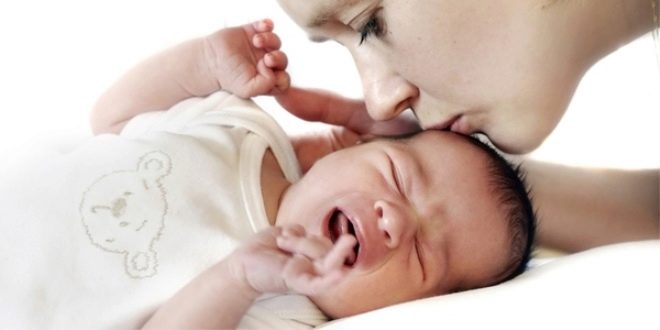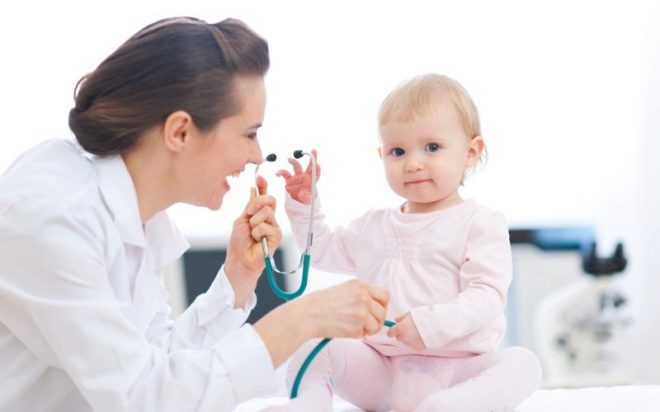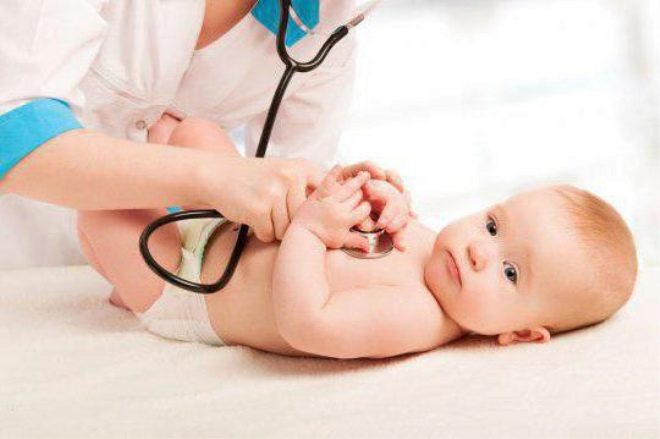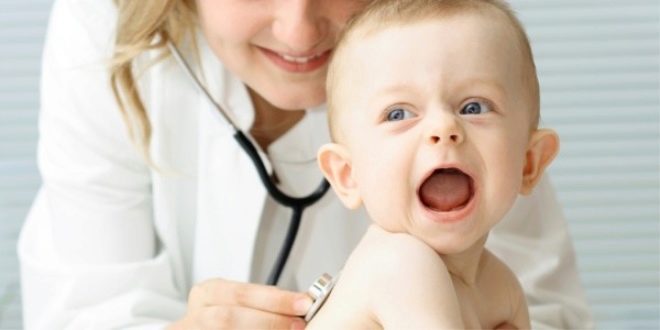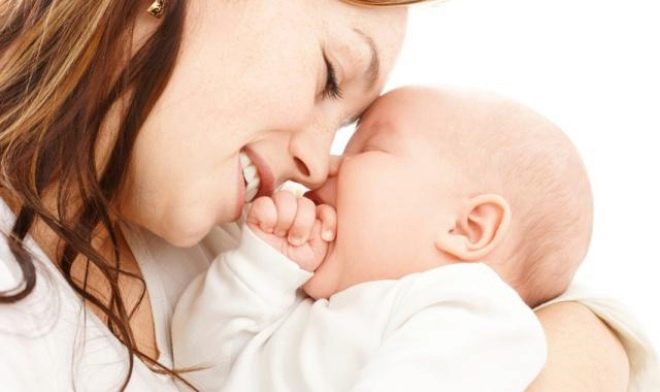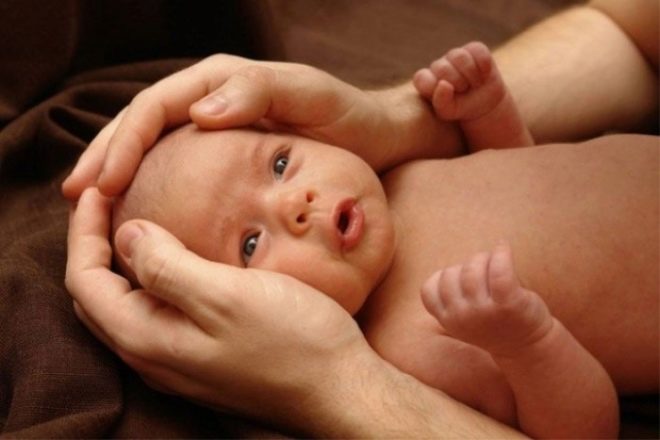Symptoms and treatment of spasmophilia in children
Doctors give such a diagnosis an example of 4% of children. Spasmophilia - a tendency to seizures is not peculiar to all babies, but only to those who have obvious signs of rickets. Why babies suffer tetany and how to treat it, we will tell in this material.
What it is
It affects spasmophilia of children from 5-6 months to 2 years. At older age, the disease is not detected. Since this age ideally coincides with the age characteristics of another typical childhood disease, rickets, spasmophilia is considered to be his “companion”. The more official name of the disease is “rickets tetany”.
The essence of the disease is reduced to the fact that neuromuscular excitability increases, there is a tendency to convulsive syndrome and spasms. Sometimes under the concept of "spasmophilia" all child convulsive states fail, but this is erroneous.
True spasmophilia is a complex process that takes place against the background of abnormal mineral metabolism in the body of a child.
A few decades ago, when the artificial washes were fed cow's milk, the number of children suffering from rickets was ten times higher. With the spread of adapted milk formulas, in which, unlike cow and goat milk, the amount of calcium and phosphorus and vitamin D is balanced, true rickets have become very rare, and hence the number of children with spasmophilia has decreased significantly.
However, pediatricians in polyclinics continue to find signs of rickets in children. In most cases, the case is in overdiagnosis - the child does not have any rickets; moreover, this diagnosis is based only on the bald patch on the back of the head and the sweating of the legs is not made.
Many modern parents understand this, but the word “rickets” scares them and makes them doubt - and what if the doctor is right and if there are signs of rickets, then there may be other negative consequences, including tetany.
This causes moms and dads to carefully look at their baby in search of certain deviations. Spasmophilia is manifested in rare cases and most of the anxieties of parents are completely in vain. But if such a disease is found in the baby, then mom and dad need to be fully armed to be able to properly assist the crumbs during a spastic attack.
In addition, spasmophilia, if it persists for a sufficiently long time, is a danger to the development of the child, since his nervous system suffers, it is possible that there is a lag in mental development and intellectual development. In severe cases, an attack leads to cessation of breathing and the death of the child.
Premature babies, as well as children with established signs of rickets, are more likely to develop infant rachitogenic tetany. The greatest number of spastic attacks occurs at the beginning of spring, when solar activity increases. To provoke an attack in a child with a tendency to tetany can and fever, and indigestion, and even prolonged crying.
The reasons
Against the background of vitamin D deficiency, the deficiency of which leads to rickets, the metabolism of calcium and phosphorus is disturbed in the child. Due to the lack of calcium and excessive loss of phosphorus in the baby’s blood, the level of ionized calcium decreases.
Calcium content is also reduced in the cerebrospinal fluid, but in the body the content of potassium increases. Phosphorus accumulates in the kidneys, but they are not able to withdraw it in full.
If the baby is sick with fever, if he cries for a long time (and this process ventilates the lungs), then an imbalance occurs in the body, the acid-base composition of the blood changes, and this is what causes a convulsive attack. In the spring, when the sun’s rays, which, when it comes into contact with the skin, contribute to the production of vitamin D, are many, a child with rickety symptoms quickly becomes oversaturated with this vitamin, the balance of minerals, alkalis and acids changes again, and this provokes a spastic attack.
Thus, the main reasons can be formulated more clearly and briefly:
- lack of vitamin D and impaired mineral metabolism (calcium and phosphorus, as well as magnesium and sodium);
- overdose with vitamins D2 and D3;
- the presence of rickets in a child in severe or moderate form.
Symptoms and symptoms
Spasmophilia in infants occurs in two variants - latent (passive) form and manifest (explicit). Ailment always begins with an inconspicuous, latent form that can last for quite a long time - several months. If there are provocative factors (fever, any acute illness, etc.), the latent stage sometimes turns into a manifest one and a convulsive seizure begins.
When hidden
Identify any symptoms with latent ricitogenic tetany is quite difficult. This can be done only with the use of special galvanic and mechanical skin samples. In general, spasmophilia will occur with symptoms characteristic of rickets - the child will show increased sweating, sleep poorly, he will be too anxious and fearful. Blood tests will be deficient in calcium, vitamin D.
Here are some special "tests" that show the readiness of the muscles for cramps, indicating the presence of latent rachytogenic baby tetany:
- Symptom Trusso. If you squeeze the brachial ganglion, then after a few minutes the brush of the upper limb will begin to contract in the form of convulsions. This phenomenon is called carpopedal spasm, and for the characteristic location of the fingers during a spasm the limb itself is called the "palm of the obstetrician."
- Symptom tail. If you gently tap on the fossae caninae with your fingertip (“goose foot” - the junction between the zygomatic arch and the corner of the mouth), then the entire half of the face, including the muscles of the mouth, eyelid and nose, will begin to shrink convulsively.
- Maslov phenomenon. If a child with spasmophilia is suddenly stabbed, then he has a brief respiratory arrest. In healthy children this does not happen - they will cry, will be indignant, but they will not stop breathing.
There are other methods based on passing a weak current through the median nerve in the elbow, as well as tapping a nerve coming out of the base of the tibia.
When manifest form
The most frequent manifestation of the manifest form is laryngospasm - a sudden involuntary contraction of the muscles of the larynx. The spasm can be easy, and can completely close the glottis, in both cases it is short-lived. The baby with laryngism is very frightened, the skin becomes sharply bluish, the crumb puffs out his eyes and becomes sharply covered with sweat. After a few seconds, the child makes a noisy breath, like a rooster's cry. Such an attack can last up to one and a half to two minutes, as well as repeated several times within one day.
Carpopedal spasm can last with obvious spasmophilia for several hours, and can torment a child for several days. With it, feet and hands are tonicly reduced. Sometimes there are spasms of the face.
Sometimes involuntary muscles are cramped, which can lead to uncontrolled urination and defecation. The most dangerous is bronchospasm, in which respiratory failure develops.
Severe manifestation of spasmophilia can be manifested by eclampsia - a common attack of the convulsive syndrome in which the child loses consciousness.Less commonly, eclampsia occurs in the form of a short-term stupor, in which the child looks inhibited and pale. More often, the contraction of the facial muscles begins, and then other muscles, including the respiratory ones, are drawn into the process. The attack can last up to half an hour.
Despite the frightening manifestations, spasmophilia rarely leads to death. The death of a child is possible only with a general convulsive attack due to the development of acute respiratory failure or problems with cardiac activity.
Diagnostics
Problems with the diagnosis of an explicit form of spasmophilia usually does not occur. If rickets is confirmed by blood tests and X-rays, complaints of convulsions or short-term loss of consciousness will be sufficient reason to make such a diagnosis to the child.
To reveal the latent form, it is necessary to apply the special symptomatic "tests" described above.
They can be done by a pediatrician or a pediatric neurologist. Suspicions of a positive reaction to a particular symptom should be confirmed or refuted by analyzes - a biochemical blood test will make it possible to judge the amount of calcium and phosphorus, and a CBS analysis will give an idea of the level of acid-base blood balance.
A child will be assigned an X-ray examination of long bones to detect rickets, if this has not been done before. It is important for the physician to distinguish spasmophilia from diseases similar in its manifestations to it - the true convulsive syndrome, epilepsy, whooping cough and congenital stridor.
Urgent Care
If a baby has laryngospasm, you need to sprinkle cold water on his face, open all the windows or air vents, and provide fresh air. Very effectively restores breath pat on the buttocks, you can also shake the baby. If these measures have been ineffective, and the child has not recovered free breathing, he should do artificial respiration, an indirect heart massage (if necessary).
With the disease in the manifest stage, with eclampsia, the child should immediately enter the necessary anticonvulsants drugs - their list will prompt the doctor if the tendency to convulsions was established earlier. Usually, emergency care includes the introduction of intramuscularly "Diazepam", the introduction of the rectal suppository "Phenobarbital." The ambulance doctors, who should be called immediately, must come injecting calcium gluconate solution intravenously, and sodium sulfate solution in the ass.
The algorithm for the actions of parents during a convulsive attack should be simple and clear: the child should be laid so that the upper part of the body is raised, preferably on the side. Immediately call the ambulance, to ensure the flow of fresh air. If the attack is not the first, anticonvulsants, as a rule, are already at the ready in the home first-aid kit and their dosage is already known to the parents. If everything happened for the first time, you should not experiment and give any medication before the arrival of the ambulance brigade.
Treatment
A baby with spasmophilia definitely needs medical attention. Hope that everything will pass as you grow, you should not. Of course, it will pass, but with what consequences, even an experienced doctor will not say. The disease must be kept under control.
Conditions such as laryngospasm and eclampsia require emergency care. If help fails and cardiac or respiratory arrest occurs, resuscitative actions will be needed.
After the seizure is stopped, the child is usually taken to the hospital, where he is under observation for at least 24 hours, since the seizures may recur.
Further therapy will be in the correction of nutrition. Cow and goat milk are completely excluded from the diet, the child is transferred to breastfeeding or feeding with artificial milk adapted mixtures. In therapeutic doses, vitamin D is prescribed.For 12 hours after the attack, starvation is recommended, the child is only watered. Then the feeding can be resumed, and children after a year are given a carbohydrate diet with fruit mashed potatoes and cereals.
As a compulsory treatment, it is recommended to take calcium preparations in the dosage established by the doctor on the basis of blood tests.
The child definitely needs long walks in the fresh air, firming massage. With obvious spasmophilia, they recommend all the same measures, but at the same time the use of anticonvulsants.
Many of them are prescription drugs, and therefore, along with the appointment, parents will receive a prescription for their purchase. It is important not to exceed the prescribed dosage. Most often, the medication is rather long in nature, for example, barbiturates are prescribed for six months.
It is important to understand that spasmophilia is not a sentence. After 2.5-3 years, there is no trace of the disease, everything goes along with rickets, the balance of calcium and phosphorus is restored. Cases of death in fact - a very rare phenomenon, but it is impossible to ignore this possibility.
Prevention
In order to prevent a child with such a diagnosis as spasmophilia, it is important to prevent the crumbs from creating the prerequisites for the development of rickets. To do this, it is best to feed the baby with breast milk, and if this is not possible, then choose an exclusively adapted formula for nutrition, which the pediatrician will recommend.
Children born in late autumn and winter must be prescribed vitamin D for prophylactic purposes. For the rest of the children, especially those living in regions where the number of sunny days is small, an aqueous or oily solution of vitamin D is also prescribed in winter and autumn.
Walking in the open air, especially in the sun, also contributes to the production of this vitamin. Children of the first year of life are given a firming massage and strengthen their immune system with hardening and water procedures. It is important to visit the pediatrician once a month so as not to miss the initial signs of rickets, if they appear.
If there is rickets, then it is important to keep a close eye on the baby, in time to reveal the hidden form of spasmophilia. This will help the doctor to adjust the diet and lifestyle of the baby so that the probability of the manifest form is minimized. If, nevertheless, the disease has happened and has come to an explicit form, then it is important to follow all the recommendations of the doctor and take the prescribed drugs. This will be an excellent prevention of recurrent seizures.
About the prevention of rickets in children, you will learn from the following video.

